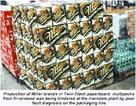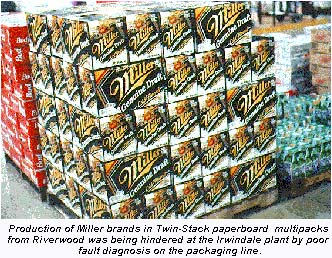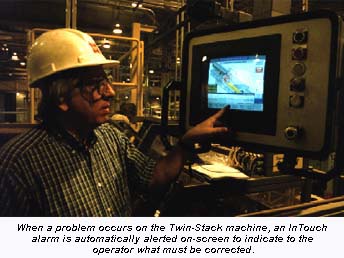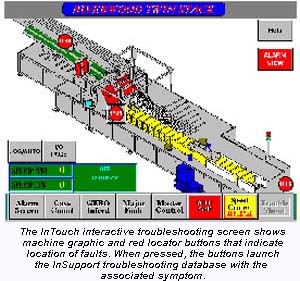Miller Smooths Bottleneck With Twin-Stack's InSupport Diagnostics

Table of Contents
Mechnical Splendor
Managing Operations
Online Troubleshooting
Line Commonality
The plant operations staff at Miller Brewing Co.'s Irwindale, CA, brewery has learned there's a big difference between a longneck bottle and a long bottleneck. Some of the brewery's best-selling retail packages of several Miller brands are party-sized containers holding up to 36 cans of beer in innovative, two-tiered Twin-Stack paperboard multipacks supplied by Riverwood International Corp. (Atlanta). However, production of these popular packages was being slowed due to downtime caused by poor fault diagnosis on the packaging line.
The 15-year-old brewery, located just east of Los Angeles, produces about 5.6 million barrels of beer each year — one barrel equals 13.7 cases of 12-oz cans. The plant has an 1,100 barrel brew house, three can and five bottle filling lines and one keg line to produce a range of products that includes Miller Beer, Miller Lite, Miller Genuine Draft, Miller Genuine Draft Light, Miller High Life, Meisterbrau, Milwaukee's Best, Sharp's, Lowenbrau, Lite Ice, Red Dog, Magnum and MG Dark and Asahi for export.

A majority of these popular brews combine promotional marketing with packaging in one step using the Twin-Stack packaging system from Riverwood. The 38-ft long, 40,000-lb machine is capable of packing up to 3,000 cans of beer per minute, neatly stacking two tiers of cans within each box. The large package size enables the use of high-impact graphics, and strong three-ply handles create an easy-to-carry package, making it convenient for consumers to buy more product.
The complexity and high performance of the Twin-Stack system requires extensive use of photo-electric and mechanical sensors to assure that machine sequences occur properly. Even a simple coating of dust on a sensor, for example, can cause a shutdown of the machine.
To prevent a possible production problem with the packaging unit due to frequent machine stoppages, Riverwood International demonstrated to Miller management a prototype of its Advanced Customer Interface Systems (ACIS). By adding an expert diagnostic system to the Twin-Stack's supervisory control system using industrial automation software from Wonderware Corp. (Irvine, CA), Riverwood created an InSupport troubleshooting application that was integrated tightly with the InTouch operator interface program used to run the machine. The resulting automated repair application has eliminated Irwindale's bottleneck.
Mechanical Splendor
The Twin-Stack system is a mechanical wonder, routing incoming conveyor lines of cans into upper and lower tiers and dividing them into configuration groups for packing the appropriate size container. Flat-fold cartons for the beer cases are picked from a magazine stack by vacuum cups mounted to a four-head rotary feeder, which unfolds each carton and aligns it for packing. A tier separator pad is inserted between the layers of grouped cans moving down the lanes, which are shunted into the opened cartons by cam-activated pusher arms. The carton flaps are hot-glued, folded over and compressed to complete the packaging process. After being coded with an expiration date, the finished packages are discharged from the machine by driven belts.
The Twin-Stack is capable of packing 12-, 15-, 18-, 20- and 24-can single-tier cases as well as 24-, 30- and 36-can twin-stack cases. Twin-Stack machines will soon be in use at all six Miller plants in the United States, but the Irwindale facility was the first to have a machine capable of handling both 12-oz and 16-oz cans. The packaging flexibility provided by the Twin-Stack system makes it easier to package different SKUs for different markets. The plant handles 100 different product SKUs for its market area, which includes primarily California and Nevada as well as export packaging for Japan.
Managing Operations
Machine operations are managed using an InTouch operator interface — called the Advanced Customer Interface Systems (ACIS) — created by Riverwood International in conjunction with the ADI Group (Milwaukee). This program runs on an Eaton FactoryMate 486-based personal computer housed in an electrical cabinet with a Modicon PLC. The two communicate via the Modbus Plus data network. The primary operator control panel consists of a 14-in color touchscreen sealed in a Hoffman console to protect it from contamination or damage in the factory.
ACIS tightly integrates the supervisory control and data acquisition features of InTouch, which had already been developed by ADI Group to Miller's specifications, with the expert diagnostics capabilities of InSupport. ACIS thus provides a graphical machine control and information center for operators that provides details on packaging parameters (in the form of recipes) as well as on machine performance and historical trend data.

There are nine main graphic displays within the main control panel, including the line conveyor, glue station, package change, vacuum pumps, clean out, carton control, machine drive/control and jog/auto, and maintenance mode. Other screens provide a machine schematic as well as information on its operation, alarms and production data.
Productivity in general is enhanced because operational adjustments and packaging changeovers can be done in a semi-automatic mode. The Twin-Stack machine can accommodate a wide range of product size and packaging combinations, so ACIS features an electronic checklist that outlines the sequence of changeover tasks. A "HELP" button is provided that pops up the exact page of the operations manual for reference during a changeover.
If problems arise, the integrated InSupport diagnostics application automates troubleshooting tasks and provides online graphical documentation to speed up repairs. The fault-model editor within InSupport maps symptoms directly to tagnames in the InTouch database. When a problem occurs, the InTouch alarm is automatically alerted on-screen and the operator can launch InSupport diagnostics.
"The beauty of this system is that it makes our operators able to handle even more of the job; they now know what to do without calling for help, and that lets us make better use of our machinists and service technicians," says Art Hogan, Miller maintenance technologist. "On those now rare occasions when a repair technician has to be called, operators can tell in advance what's wrong with the machine and they know what parts to bring. Plus the online documentation eliminates having to carry large manuals to the machine site."
Online Troubleshooting
When a fault occurs, the ACIS main fault screen pops up a flashing red circle on the machine schematic on the operator's screen to indicate where the problem is located and to describe the fault. Experienced operators can usually go directly to the site and correct the fault immediately. Less experienced operators can simply press the red flashing circle on the touchscreen, and the onboard troubleshooting database will be launched. The most probable cause of the fault will be prompted in the database.

Unlike traditional troubleshooting systems that rely on "logic tree" methodology, InSupport provides the ability to analyze multiple symptoms and create a single, more cost-effective strategy to improve troubleshooting efficiency and reduce downtime. InSupport also allowed Riverwood to integrate work instructions with online documentation. Operators not familiar with a specific area of the Twin-Stack machine can click on a "HOW?" button for detailed information in text and graphic form. The operator is then immediately linked to the exact page in the electronic manual that contains information about possible solutions.
Digitized photos of machine subsystems and on-screen text instruct operators or technicians how to check InSupport's repair suggestion. If the first attempt doesn't solve the problem, ACIS supplies the next most probable suggestion. The system also has an interactive strategy screen that lets Miller technicians customize fault correction techniques. If a particular failure occurs consistently, its cause can be repositioned in the database to be the first suggestion proposed.
"We've found this support package to be so useful to our operators that in most cases we don't even have to call on maintenance technicians anymore," says Hogan. "In many cases, the faults are such simple things to correct that we're making far better use of everyone's time."
The same techniques speed up product changeovers, according to Hogan. The system provides recipes and machine setup parameters that can be handled via the on-screen checklist. The ASIC checklist literally makes operators check photo eyes, sensors, glue preparation, carton loaders, resetting the carton rotary clutch, etc., for every packaging size and type possible. During a run, the system also alarms conditions such as a can that's fallen on its side, a palletizer misfeed or even insufficient cans to run.
Through it all, ACIS maintains a time-stamped log of all tasks, failures and repairs so Miller production managers can track equipment use and problems over time. Operators can even enter repair tips and notes in the program's comment section, so each new symptom and solution immediately becomes part of the system's body of knowledge for use by other workers on other shifts.
Line Commonality
Hogan adds that in addition to the InSupport/InTouch system implemented on the Twin-Stack machine, Miller's Irwindale plant is using InTouch on several other applications, including the brew house, filler lines and palletizer lines. This way, all operators know how to interact with any of the systems, and the plant is able to use people more productively among departments. "The intent at Miller is to provide a common look and feel to our lines," says Hogan.
"The Twin-Stack system has helped us make a big increase in our packaging capabilities," Hogan summarizes. "The logistics of meeting seasonal demand, such as during the summertime and major holidays, meant that we often had to work three full shifts to keep up with production. With the capacity that this system provides we no longer have that bottleneck."
Hogan concludes, "Since a lot of the competition in the beer business is to get the product to market faster, we feel we're able to respond in such a way that it's no longer an issue."
For more information:
Riverwood International Corp., 3350 Cumberland Cir., Ste. 1400, Atlanta, GA 30339, Tel: 770-644-3000, Fax: 770-644-2999.
Wonderware Corp., 100 Technology Dr., Irvine, CA 92618, Tel: 714-727-3200, Fax: 714-727-3270.
Edited by Bill Noone
